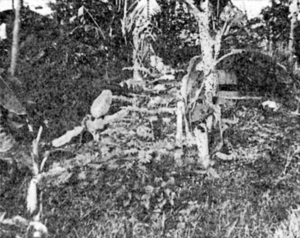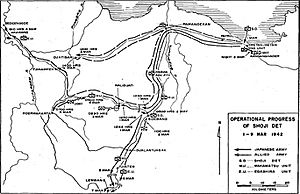Battle of Tjiater Pass facts for kids
Quick facts for kids Battle of Tjiater Pass |
|||||||
|---|---|---|---|---|---|---|---|
| Part of Battle of Java in the Dutch East Indies campaign | |||||||
 A Dutch pillbox at Tjiater pass |
|||||||
|
|||||||
| Belligerents | |||||||
|
|
|||||||
| Commanders and leaders | |||||||
| Units involved | |||||||
| Strength | |||||||
| 9,000 27 aircraft |
3,000 39 aircraft |
||||||
The Battle of Tjiater Pass was an important fight during World War II. It happened between March 5 and 7, 1942. This battle took place in the Dutch East Indies (which is now Indonesia). Japanese forces fought against Dutch colonial soldiers, who were also helped by planes from the Royal Air Force (RAF).
The battle was fought for control of the Tjiater Pass (now called Ciater). This pass was a key mountain route leading to the city of Bandung. The Dutch forces wanted to defend Bandung, a major city, after losing other areas.
Even though the Japanese forces, led by Colonel Toshinari Shōji, had fewer soldiers, they attacked first. They wanted to stop the Dutch from getting stronger. The Japanese had better air support and training. They managed to capture the Dutch defenses at the pass after three days. This opened their way to Bandung. The Dutch soldiers were tired and losing hope. To avoid more fighting in Bandung, the Dutch surrendered soon after this battle. This led to the Japanese taking control of the entire Dutch East Indies.
Contents
Why the Battle Happened
Japanese Landings and Dutch Retreat
After winning the Battle of the Java Sea, Japanese soldiers landed on the island of Java. This happened on March 1, 1942. One group, led by Colonel Toshinari Shōji, landed at Eretan Wetan. They quickly took control of the Kalijati airfield. This allowed Japanese planes to move closer and help their ground troops.
From the Kalijati airfield, there were two main roads to the city of Bandung. One went through Purwakarta, and the other was through the Tjiater Pass. The Tjiater Pass was in the mountains near Tangkuban Perahu.
Dutch Defense Plans
The Dutch forces tried to attack the Japanese on March 2 and 3. They wanted to get the Kalijati airfield back, but they failed. These attacks used up a lot of their soldiers and supplies.
The Dutch "West Group" was ordered to leave Batavia and Buitenzorg on March 4. Another group, the "Bandoeng Group," was told to defend Bandung. They needed to hold the city until the West Group could join them. Major General Jacob Pesman led the Bandoeng Group. The Dutch hoped that by joining forces, they could stop the Japanese advance.
Who Fought in the Battle
Dutch Forces and Their Challenges
Major General Pesman had about 9,000 soldiers. This included 5,900 from his original group and extra soldiers. However, these units were spread out to defend many places. Some of his soldiers had also lost their fighting strength.
The Dutch had 27 working airplanes. These included bombers, fighters, and planes for looking around. The "West Group" was expected to arrive in Bandung between March 6 and 7. They would be ready to fight by March 10. Until then, the Bandoeng Group had to defend the city alone.
The Dutch had built defenses at both mountain passes leading into Bandung. Colonel W.J. de Veer was in charge of these defenses.
Japanese Forces and Their Strategy
The Japanese command wanted Colonel Shōji's forces to just hold their captured areas. They were supposed to wait for more soldiers to arrive. But Shōji decided to attack Bandung instead. He gathered his soldiers to push through the Tjiater Pass. He was worried about Dutch air attacks and counterattacks.
Shōji's group had about 3,000 soldiers. They were better trained and had more experience than the Dutch. About 2,000 to 2,400 of them fought in the battle. The Japanese also had 39 airplanes ready to fly. These included bombers, attack planes, fighters, and one reconnaissance plane.
Defenses at Tjiater Pass
The defenses at Tjiater Pass were built to be held by a large group of soldiers. They had trenches, two lines of strong concrete shelters called casemates, and barbed wire. The first defense line was about two kilometers long. It was right in front of a deep ditch.
When the battle started, only one group of soldiers was defending this line. They had some extra support units. There was also a second defense line further back, but it wasn't fully built. The first line was not fully staffed. It also had problems because there weren't enough workers to finish building it after the Japanese invasion.
The Battle Unfolds
Air Raids and First Clashes
On the morning of March 4, both sides attacked each other from the air. Dutch and RAF planes bombed Japanese landing spots and the Kalijati airfield. Japanese planes attacked the Dutch airbase at Andir and Dutch defenses. Because of these air raids, the Dutch soldiers in front pulled back to Lembang, where most of their forces were. Air raids continued on both sides into the next day.
The ground battle for the pass started around noon on March 5. Japanese light tanks met Dutch defenses, including small concrete bunkers called pillboxes and a 5-cm gun. The Dutch only had four guns to support their defenders. The pillboxes also didn't work as well because of thick trees.
Japanese Push Through Defenses
After about three hours, Japanese soldiers reached the front defenses. About 50 Dutch soldiers pulled back. The Dutch destroyed their 5-cm gun and blew up a bridge. As the Dutch retreated, the main defense line fired at the Japanese with mortars and machine guns. The Japanese fired back with their own mortars.
Within half an hour, Japanese soldiers got into parts of the defense line that were not guarded. They tried to surround the Dutch soldiers. This forced the Dutch to retreat to their second defense line, about 500 meters away. This second line was not good for seeing the enemy, and some equipment was left behind. By 4 PM, the Japanese were firmly in the first line. They exchanged fire with the Dutch in the second line but could not make them leave.
Reinforcements and Retreat
Major General Pesman sent more soldiers to Tjiater. But they were delayed by a traffic jam. When they arrived, some Japanese soldiers had already gotten into the second line. More Dutch soldiers arrived, and the men in the second line were moved out before daylight on March 6. A new defense line was set up behind the old one, with about 950 soldiers. Behind this, only 400 inexperienced soldiers defended the southern exit of the pass. The Japanese had captured five pillboxes and stopped their attack for the day.
Heavy Fighting on March 6
On March 6, the Japanese first thought the Dutch had 3,000 soldiers. But after questioning a captured prisoner of war, they learned the Dutch had far fewer. The Japanese had about 1,000 men in the pass. They also had more mortars and tanks. Many Japanese air raids dropped hundreds of bombs, destroying vehicles and making the Dutch soldiers lose hope.
The first Japanese attacks on March 6 started around 5:30 AM. They attacked the western part of the Dutch defense line. The Dutch pushed back the first two attacks. But the Japanese launched a third attack with mortar fire and three tanks. This attack broke through the two Dutch companies defending that area. The Japanese used thick fog to surprise the Dutch. Many Dutch soldiers were killed or captured. Later, it was found that 120 soldiers from these two companies died in the fighting or after being captured.
By midday, Japanese patrols were exchanging fire with Dutch soldiers in the unfinished defenses. In the afternoon, the Japanese managed to go around the Dutch defenses. They attacked from the side, but the Dutch fought back and pushed them away. However, Colonel de Veer was killed in this counterattack. The remaining Dutch defenders were ordered to retreat to Lembang.
Final Push to Lembang
After capturing the positions, the Japanese controlled the high ground of the mountain pass. The Dutch forces had weak defenses left. On March 7, the Japanese finished clearing out any remaining Dutch units near the ridgeline. Japanese soldiers continued to move towards Lembang. Their advance was stopped for a short time at a destroyed bridge. After more fighting, the Dutch units in Lembang began to retreat further towards Bandung.
What Happened Next
Dutch Surrender
With the Japanese controlling the mountain pass, the Allied forces in West Java knew they could not hold on. On the night of March 7, Japanese forces entered and occupied Lembang. There, they met a Dutch messenger carrying a flag of truce.
The Dutch first wanted to discuss only the surrender of their soldiers in the Bandung area. But the Japanese 16th Army Commander, Hitoshi Imamura, demanded that all Allied forces in the Dutch East Indies surrender. This discussion happened the next day at Kalijati Airfield. The Dutch governor-general, Alidius Tjarda van Starkenborgh Stachouwer, and the military commander, Hein ter Poorten, at first refused a total surrender.
End of the Campaign
Some of the "West Group" soldiers arrived in Bandung. Their commander thought about fighting a guerilla war against the Japanese. But he decided against it because conditions were not good. Bandung was full of many people who had fled their homes. To avoid more fighting in the city, the Dutch authorities announced their general surrender at noon on March 9. The official surrender papers were signed less than three hours later. This battle was a key step in the Japanese taking control of the Dutch East Indies.
Images for kids




